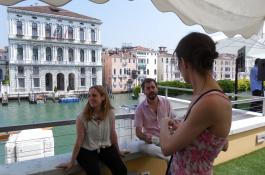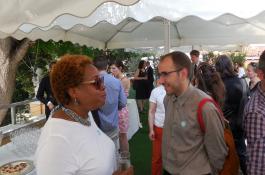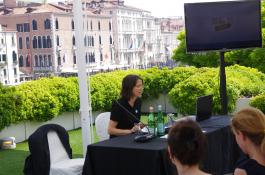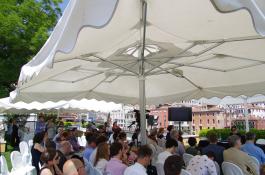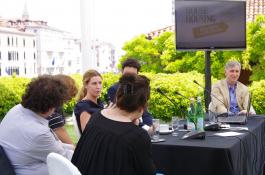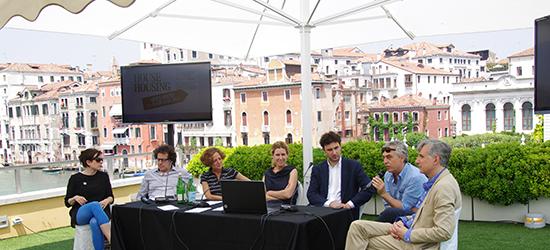June 7, 2014
Peggy Guggenheim Collection, Venice
This event was co-organized by Gaia Caramellino and the Buell Center in conjunction with the exhibition, House Housing: An Untimely History of Architecture and Real Estate in Nineteen Episodes, in order to open up a critical conversation regarding the role(s) played by finance, real estate, and their imaginaries in architecture, with special attention given to housing. The importance of these factors is undeniable in an era characterized, in many locales, by the accumulation of disproportionate private wealth, alongside the privatization of formerly public assets, like housing, and their recirculation as real estate. The ultimate aim is to address the ubiquity of real estate and its imaginaries in the contemporary city and to sketch their histories, recognizing that these logics shape vast areas of architectural production, including otherwise experimental work.
The panel’s title, “Fundamental #13,” refers to the overall curatorial theme proposed by Curator of the 14th International Architecture Exhibition, Rem Koolhaas: “Fundamentals,” and to the sub-theme, “Elements of Architecture,” of which there were originally twelve. Whether numerologically lucky or unlucky, “Fundamental #13”—land, as real estate—performs a magic trick, by converting substance into money and back again. Like the House Housing exhibition, the panel therefore supplements the Biennale’s main themes with another fundamental architectural element and its histories.
Panelists
Stefano Boeri, architect, lives and works in Milan. His professional firm has designed buildings in Italy and abroad. Boeri is Professor of Urban Design at the Politecnico di Milano and has taught courses as "visiting professor" at various universities, including Harvard GSD, Strelka/Moscow, the Ecole Polytechnique de Losanne, and the Berlage Institute. From 2004 to 2007 he was director of the international journal Domus, from September 2007 to April 2011 he directed the international magazine Abitare,and he has been the artistic director of the International Festival of Architecture FESTARCH. He is the founder of the research agency "multiplicity," which is devoted to the study of the transformations of the city viewed from different disciplinary angles. Multiplicity has been invited to present its research at numerous international exhibitions such as Documenta XI/Kassel, The Musée d'Art Modern in Paris, and the Venice Biennale, and has promoted and participated in collective volumes such as Mutations (Actar , 2000), USE (Skira, 2002) and Milano, Cronache dell'Abitare (Mondadori, 2007). Boeri has published his studies and projects on Milan in Il Territorio che Cambia (with A.Lanzani and E.Marini, Segesta, 1993) and Biomilano (curated by M.Brunello, Corraini, 2011), and as the author of two recently published books: Anticittà(Laterza, 2011) and Fare di Più con Meno (Laterza, 2012). From June 2011 to March 2013 he was Councilor for Culture, Design and Fashion of the City of Milan.
Gaia Caramellino, architect, Ph.D., is research fellow in History of architecture and urban planning at the Politecnico di Torino and teaches at the Politecnico di Milano. Since 2010, she has been the coordinator of the research project “Architectures for the Middle-classes in Italy: 1950s-1970s. For a social history of dwelling in Turin, Milan and Rome”, funded by the Italian government. Her research focuses on the history of housing policies, models, cultures and practices during the 20th century. She has been awarded several grants and fellowships (Rockefeller Foundation, Radcliffe Institute of Advanced Studies, Graham Foundation, SAH) and was a Visiting Scholar at the Canadian Center for Architecture in 2011. Among her recent books are William Lescaze. Un architetto europeo nel New Deal (2010, forthcoming in English, 2014) and Storie di Case. Abitare l’Italia del boom (co-edited with F. De Pieri, B. Bonomo and F. Zanfi, 2013).
Ludovico Centis is an architect, and founder and editor of the architecture magazine San Rocco. He has been a partner at the architectural office Salottobuono from 2007 to 2012. He is currently a doctoral candidate in urbanism at IUAV University in Venice (Italy). He has lectured at Università IUAV di Venezia (Venice), the Politecnico in Milan, Festarch (Cagliari), the Auditorium dell’Ara Pacis (Rome), the Hong Kong & Shenzhen Biennale of Urbanism (Hong Kong), the Palais de Tokyo (Paris), the Architectural Association School of Architecture (London), the Faculté d’Architecture La Cambre Horta (ULB, Brussels), the 21er Haus (Vienna), and Cornell University (Ithaca, NY). Centis has most recently been the 2013-2014 Peter Reyner Banham Fellow at the SUNY - University at Buffalo.
Marie Antoinette Glaser, Dr. phil., researches as cultural anthropologist and lecturer at the ETH Wohnforum—ETH CASE Centre for Research on Architecture, Society & the Built Environment at ETH Zurich. She is scientific director and Co-convenor (with Prof. Dietmar Eberle) of the interdisciplinary MAS ETH ARCH Housing course. Her research approach contains cultural studies in architecture, social and cultural history of Housing, social sustainability; Recent research on “Potentials and problems of Swiss post 1950s large residential housing estates—House-Biographies”, granted by the SNF. Recent book publication on “Vom guten Wohnen. Vier Zürcher Hausbiografien von 1915 bis zur Gegenwart” at Niggli publishers.
Juan Herreros is Chair Professor at the School of Architecture of Madrid and Professor in Practice at the Graduate School of Architecture of Columbia University in NY. He runs a 20-architect office based in Madrid that operates under www.estudioherreros.com. His built work has been broadly and internationally awarded, published, and exhibited. His office is now developing and building different projects in Spain, Norway, Panama, Mexico, Colombia, France, and Morocco. For all of that, he has been distinguished with, among others, the International Fellowship Award of the Royal Institute of British Architects (RIBA), the AD prize of Architecture, and has a nomination for the medal of the American Academy of Arts and Letters. At this moment, his most significant projects under development are the Edward Munch Museum in Oslo and the Convention Center Ágora-Bogotá in Colombia—and on the real-estate side, three important hybrid residential+commercial+offices complexes in Oslo, Marseille and Casablanca.
Paola Viganò, is an architect and Professor in Urbanism and Urban Design at Università IUAV of Venice and at the EPFL (Lausanne); Guest professor at KU Leuven; Aarhus school of Architecture; Harvard GSD. In 2013 she receives the French Grand Prix de l’Urbanisme et de l’Art Urbain. In 1990 she founded Studio with Bernardo Secchi realizing among others the Park Spoornoord and Theaterplein in Antwerp, together with the Structural Plan for the city; the central public spaces in Mechelen, the cemetery in Kortrijk, Belgium and in La Courrouze, Rennes, France. In 2009 and 2012 Studio has worked on the “Greater Paris” project and on “New Moscow”. In 2011–2012 Studio has developed a vision for Brussels 2040. It is today part of the Atelier International du Grand Paris. Among her books: I territori dell’urbanistica, il progetto come produttore di conoscenza, Officina, Roma 2010 (french transl. Les territoires de l’urbanisme, Le projet comme producteur de connaissance, MetisPresses, Geneva 2012).
Photos: Oskar Ornorsson
Video: ENDAR
